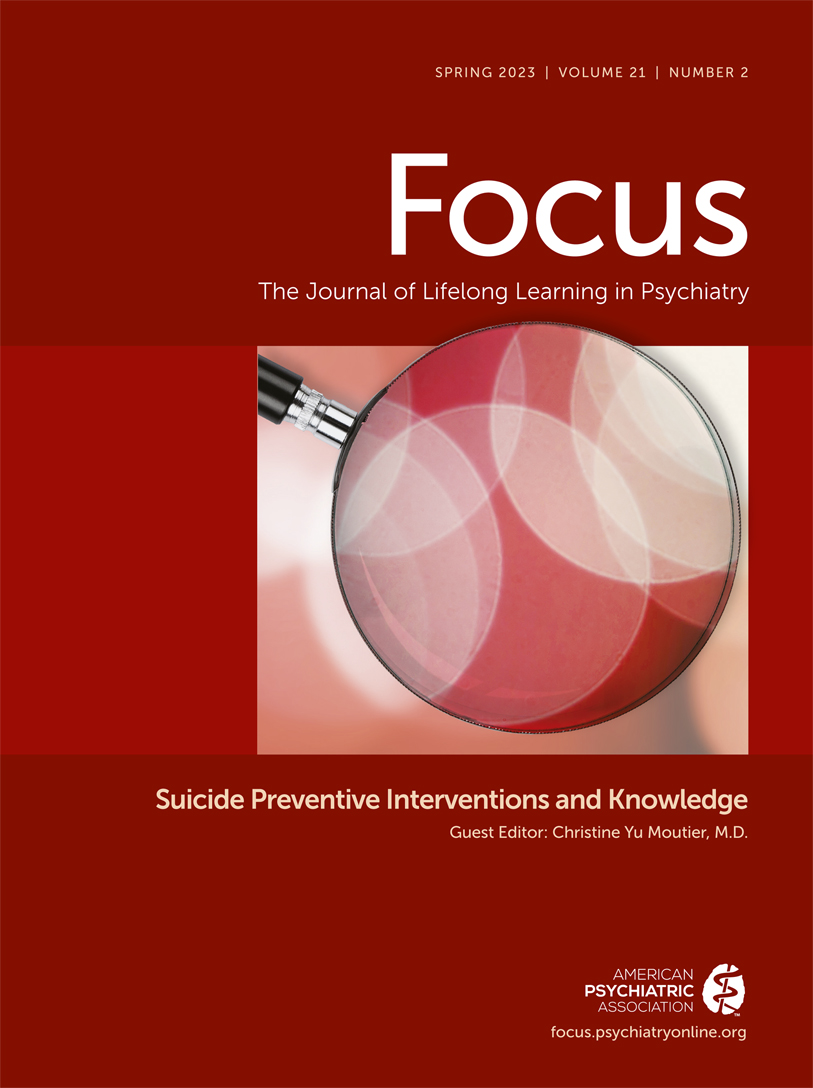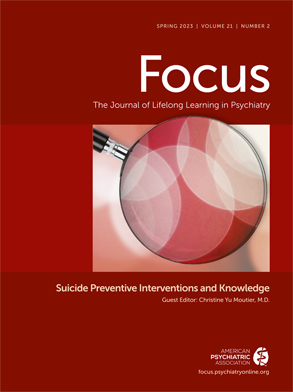Given space limitations and varying reprint permission policies, not all of the influential publications the editors considered reprinting in this issue could be included. This section contains abstracts from additional articles the editors deemed well worth reviewing.
Validation of the Ask Suicide-Screening Questions (ASQ) With Youth in Outpatient Specialty and Primary Care Clinics
Aguinaldo LD, Sullivant S, Lanzillo EC, et al.
Gen Hosp Psychiatry 2021; 68:52–58
OBJECTIVE: Validate the Ask Suicide-Screening Questions (ASQ) with youth in outpatient specialty and primary care clinics.
METHOD: This is a cross sectional instrument validation study assessing the validity of the ASQ with respect to the standard criterion, Suicidal Ideation Questionnaire (SIQ/SIQ Jr.). The sample included 515 English speaking youth ages 10–21 years old from outpatient specialty and primary care clinics. ASQ sensitivity, specificity, positive and negative predictive values (PPV/NPV), positive and negative likelihood ratios, c statistic and respective receiver operating characteristic curves were assessed.
RESULTS: A total of 335 outpatient specialty and 180 primary care clinic participants completed the study. In outpatient specialty clinics, the ASQ showed a sensitivity of 100.0% (95% CI: 80.5–100.0%), specificity of 91.2% (95% CI: 87.5–94.1%), and NPV of 100.0% (95% CI: 98.7–100.0). In the primary care clinic, the ASQ showed a sensitivity of 100.0% (95% CI: 59.0–100.0%), specificity of 87.9% (95% CI: 82.0–92.3%), and NPV of 100.0% (95% CI: 97.7–100.0). Forty-five (13.4%) outpatient specialty clinic participants and 28 (15.6%) primary care clinic participants screened positive for suicide risk on the ASQ.
CONCLUSIONS: The ASQ is a valid screening tool for identifying youth at elevated suicide risk in outpatient clinical settings.
Copyright 2021 Elsevier. Reprinted with permission.
Suicide Attempts and Nonsuicidal Self-Injury in the Treatment of Resistant Depression in Adolescents: Findings from the TORDIA Study
Asarnow JR, Porta G, Spirito A, et al.
J Am Acad Child Adolesc Psychiatry 2011; 50:772–781
OBJECTIVE: To evaluate the clinical and prognostic significance of suicide attempts (SAs) and nonsuicidal self-injury (NSSI) in adolescents with treatment-resistant depression.
METHOD: Depressed adolescents who did not improve with an adequate SSRI trial (N=334) were randomized to a medication switch (SSRI or venlafaxine), with or without cognitive-behavioral therapy. NSSI and SAs were assessed at baseline and throughout the 24-week treatment period.
RESULTS: Of the youths, 47.4% reported a history of self-injurious behavior at baseline: 23.9% NSSI alone, 14% NSSI+SAs, and 9.5% SAs alone. The 24-week incidence rates of SAs and NSSI were 7% and 11%, respectively; these rates were highest among youths with NSSI+SAs at baseline. NSSI history predicted both incident SAs (hazard ratio [HR]=5.28, 95% confidence interval [CI]=1.80–15.47, z=3.04, p=.002) and incident NSSI (HR=7.31, z=4.19, 95% CI=2.88–18.54, p<.001) through week 24, and was a stronger predictor of future attempts than a history of SAs (HR=1.92, 95% CI=0.81–4.52, z=2.29, p=.13). In the most parsimonious model predicting time to incident SAs, baseline NSSI history and hopelessness were significant predictors, adjusting for treatment effects. Parallel analyses predicting time to incident NSSI through week 24 identified baseline NSSI history and physical and/or sexual abuse history as significant predictors.
CONCLUSIONS: NSSI is a common problem among youths with treatment-resistant depression and is a significant predictor of future SAs and NSSI, underscoring the critical need for strategies that target the prevention of both NSSI and suicidal behavior.
Clinical Trial Registration Information: Treatment of SSRI-Resistant Depression in Adolescents (TORDIA). URL:
http://www.clinicaltrials.gov. Unique Identifier: NCT00018902.
Copyright 2011 Elsevier. Reprinted with permission.
Lithium and Suicide Prevention in Mood Disorders and in the General Population: A Systematic Review
Del Matto L, Muscas M, Murru A, et al.
Neurosci Biobehav Rev; 116:142–153
Suicide contributes to 1–4% of deaths worldwide every year. We conducted a systematic review aimed at summarizing evidence on the use of lithium for the prevention of suicide risk both in mood disorders and in the general population. We followed the PRISMA methodology (keywords: “lithium,” “suicide” AND “suicidal” on Pubmed, Cochrane CENTRAL,
Clinicaltrial.gov, other databases). Inclusion criteria: lithium therapy in mood disorder or found in drinking water or scalp in the general population. Exclusion criteria: no lithium administration. From 918 screened references, 18 prospective (number of participants: 153786), 10 retrospective (number of participants: 61088) and 16 ecological studies (total sample: 2062) were included. Most of the observational studies reported a reduction in suicide in patients with mood disorders. All studies about lithium treatment’s duration reported that long-term lithium give more benefits than short-term lithium in suicide risk. The evidence seems to attribute an intrinsic anti-suicidal property of lithium, independent of its proven efficacy as a mood stabilizer.
Copyright 2020 Elsevier. Reprinted with permission.
Universal Pediatric Suicide Risk Screening in a Health Care System: 90,000 Patient Encounters
Roaten K, Horowitz LM, Bridge JA, et al.
J Acad Consult Liaison Psychiatry 2021; 62:421–429
BACKGROUND: Suicidal behavior is increasing among US youths. Contact with the health care system is common in the months before suicide.
OBJECTIVE: To assess the characteristics of suicide risk among youths presenting for health care, universal screening results from a large hospital system were analyzed.
METHODS: A retrospective analysis of the Ask Suicide-Screening Questions tool administered to patients aged 10–17 years in a hospital system including an emergency department, inpatient medical units, and primary care clinics was conducted. Demographic and clinical data from 3 years of encounters were analyzed.
RESULTS: The sample consisted of 91,580 pediatric encounters, predominantly white Hispanic and women, with one-third speaking Spanish. Across health care settings, 2.9% of encounters produced positive suicide risk screens, with the highest rate in the emergency department (8.5%). Acute positive screens, indicating imminent risk for suicidal behavior, accounted for 0.3% of all encounters. Approximately one-fourth (27.6%) of encounters for psychiatric presenting problems screened positive compared with 2.3% for nonpsychiatric encounters. Higher rates of positive screens were present among encounters for psychiatric presenting problems across all settings. Positive screens were less common among preteen (1.8%) than adolescent (3.1%) encounters (χ2=65.50, P<0.001).
CONCLUSIONS: Universal screening detected suicide risk in approximately 3% of pediatric health care encounters. Screening identified risk in encounters among preteen and adolescent patients, with a higher prevalence of positive screens in encounters for youths presenting with psychiatric problems and for emergency department visits. Acute positive screens were rare, occurring in less than half of 1 percent of encounters.
Copyright 2021 Elsevier. Reprinted with permission.
Implementing a Systems Approach to Suicide Prevention in a Mental Health Service Using the Zero Suicide Framework
Turner K, Sveticic J, Almeida-Crasto A, et al.
Aus N Z J Psychiatry 2021; 55:241–253
OBJECTIVE: The Zero Suicide Framework, a systems approach to suicide prevention within a health service, is being implemented across a number of states in Australia, and internationally, although there is limited published evidence for its effectiveness. This paper aims to provide a description of the implementation process within a large health service in Australia and describes some of the outcomes to date and learnings from this process.
METHOD: Gold Coast Mental Health and Specialist Services has undertaken an implementation of the Zero Suicide Framework commencing in late 2015, aiming for high fidelity to the seven key elements. This paper describes the practical steps undertaken by the service, the new practices embedded, emphasis on supporting staff following the principles of restorative just culture and the development of an evaluation framework to support a continuous quality improvement approach.
RESULTS: Improvements have been demonstrated in terms of processes implementation, enhanced staff skills and confidence, positive cultural change and innovations in areas such as the use of machine learning for identification of suicide presentations. A change to ‘business as usual’ has benefited thousands of consumers since the implementation of a Suicide Prevention Pathway in late 2016 and achieved reductions in rates of repeated suicide attempts and deaths by suicide in Gold Coast Mental Health and Specialist Services consumers.
CONCLUSION: An all-of-service, systems approach to suicide prevention with a strong focus on cultural shifts and aspirational goals can be successfully implemented within a mental health service with only modest additional resources when supported by engaged leadership across the organisation. A continuous quality improvement approach is vital in the relentless pursuit of zero suicides in healthcare.
Copyright 2021 Sage. Reprinted with permission.

